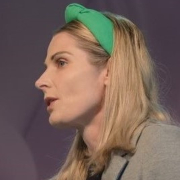AI is key to helping us detect, adapt, and respond to climate change and help in decarbonisation efforts. As the UK’s AI roadmap points out:
AI technologies are an essential part of the toolbox for innovating to reduce greenhouse gases in the atmosphere, and to reduce the environmental impacts of goods, services and human activities.
Transforming every sector of the economy
Yet separating the two fields persists. Despite both climate action and AI being far reaching, cross-disciplinary fields that will both transform every sector of the economy in the years ahead.
This reluctance to view AI and environmental sustainability together is because of two key reasons:
- The way the risks of AI are represented.
- The language and imagery used to discuss the two concepts.
Despite these challenges, AI and related technologies are key to ensuring the pledges of the United Nations Climate Change Conference (COP26) are delivered in a fair and just way.
The way the risks of AI are represented
There are many examples of flawed AI systems that have perpetuated gender and racial biases, in effect creating a barrier for a diverse and inclusive society and economy. For example, Caroline Perez highlights many diverse examples of the gender data gap.

Credit: Christian Horz, Getty Images
There are other examples that cover nearly every type of human activity, from bias in correctional offender profiling, to unequal access to financial products.
Popular culture also highlights when AI is at odds with our interests and wellbeing. For example, the star-studded 2021 film Don’t look Up was as much a comment on malevolent AI as it was on failures to address climate change.
The focus on potential bias in AI has shown the risks of the technology. But there are also a range of opportunities associated with its use, and a cost of not engaging, of being ‘left behind’.
Exploring language and imagery
Technology researcher Kate Crawford highlighted a seemingly obvious point that running an image search of ‘AI’ returns dozens of pictures of glowing brains and blue-tinted binary code floating in space.
She uses this observation to critique the industry itself. Showing that AI language and images fail to depict the lasting costs and long histories of the materials needed to build computational infrastructures or the energy required to power them.
She points out that AI metaphors like ‘the cloud’ imply something floating and delicate within a natural industry when in fact the cloud is a resource intensive, extractive technology.
Other examples prompting more reflective and responsible practices within the tech industry itself include awareness raising of the poor environmental record of cryptocurrencies.
For example, public pressure via environmental social and governance (ESG) related concerns influenced Tesla to change their policy on bitcoin.
Highly impactful tool
Yet AI represents only part of the 1.4% of global greenhouse gas (GHG) emissions associated with information and communication technologies.
In absolute GHG emission terms it’s a relatively small sector, compared with others such as transport, homes, and buildings. It’s as a tool that AI can be highly impactful across all sectors.
So, while Crawford used language and imagery observations to critique the AI industry itself, it’s also a starting point to explain the lack of shared vocabulary between AI and net zero more generally.
Compare for example the intangible, ephemeral, blue-tinted binary code floating in space with our language of images of the environment. Search for ‘environmental sustainability’ and the images depict trees, hands holding the earth, humans planting seeds.
Separate fields
Industries with large GHG emissions in absolute terms, such as transport and agriculture, are depicted by equipment, vehicles, and machinery. In each instance the example provided is a highly tangible, material image.
The opposite of the intangibility of AI and hence yet another reason why the two fields are so often separate.
The 2021 publication The Age of AI and Our Human Future by Henry A Kissinger, Eric Schmidt and Daniel Huttenlocher takes this idea a step further. It comments that it is not just disparate images that provide a barrier but the complete absence of necessary languages stating:
Few eras have faced a strategic and technological challenge so complex and with so little consensus about either the nature of the challenge or even the vocabulary necessary for discussing it.

Credit: David Man and Tristan Ferne, Better Images of AI, Trees, CC-BY 4.0
COP26 and beyond: the AI link
COP26 commentary highlighted that whilst pledges and new international initiatives were highly encouraging and meaningful, there is a gap between pledges and detailed, short-term plans.
For example, the number of net zero pledges from city regions and companies has almost doubled since late 2019. Yet net zero commitments vary hugely in their quality leaving open the risk of greenwashing.
This is where AI and related technologies can help. Organisations need specific, actionable intelligence about the environmental risks that they face.
These technologies will also be essential in monitoring environmental changes and tracking progress towards United Nations sustainable development goals.
Fairer and greener
One of the strengths of COP26 was the representation of small nations that are at risk despite hardly contributing to GHG emissions. In other words, those most affected by climate change including youth and indigenous peoples, had a voice at the decision-making table.

Credit: courtneyk, Getty Images
AI and related technologies can also continue this push towards a fairer, greener future. The recent announcement by the International Energy Agency (IEA) that they are considering making reports freely available is one such example that has impact across a range of sectors.
The quality of data the IEA collects is believed to have less bias than the other data sources and its global energy systems reports are highly influential.
It provides a crucial data resource for combating climate change. But much of the data in its reports is behind paywalls that are prohibitively expensive for:
- less wealthy countries
- civil society
- under-resourced or underprivileged areas.
From inconvenient truth to net zero
Advances in AI and related technology provide an enormous range of opportunities to help us achieve the goals of COP26 and ensure a successful net zero journey.
AI can help us:
- de-risk
- reduce costs
- respond faster
- detect problems
- adapt, and
- respond to the climate emergency.
The questions asked of us are sometimes uncomfortable but the potential of addressing social, economic and climate injustice makes the efforts vital to our future.
Further information
You can connect with Sarah on LinkedIn
Follow Innovate UK on Twitter
Connect with Innovate UK on LinkedIn
Follow Innovate UK on Facebook
You can go to the new Innovate UK website
You can go to the Innovate UK EDGE website
Subscribe to our YouTube channel
Sign up for our email newsletter
Top image: Credit: metamorworks, Getty Images



